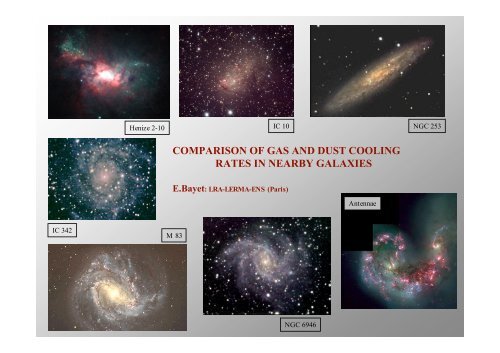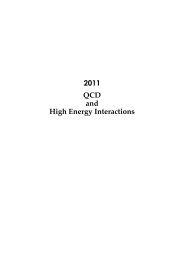comparison of gas and dust cooling rates in - Rencontres de Moriond
comparison of gas and dust cooling rates in - Rencontres de Moriond
comparison of gas and dust cooling rates in - Rencontres de Moriond
You also want an ePaper? Increase the reach of your titles
YUMPU automatically turns print PDFs into web optimized ePapers that Google loves.
IC 342<br />
Henize 2-10<br />
M 83<br />
IC 10<br />
COMPARISON OF GAS AND DUST COOLING<br />
RATES IN NEARBY GALAXIES<br />
E.Bayet: LRA-LERMA-ENS (Paris)<br />
NGC 6946<br />
Antennae<br />
NGC 253
E. Bayet<br />
INTRODUCTION :<br />
<strong>Moriond</strong> – March, 6th-12th 2005<br />
OBJECTS : warm <strong>and</strong> <strong>de</strong>nse molecular clouds <strong>in</strong> the nuclei <strong>of</strong> 20 nearby galaxies with<br />
different morphological types (D < 10 Mpc)<br />
targets for ALMA <strong>and</strong> Herschel<br />
GOALS : 1) <strong>de</strong>scribe the physical properties <strong>of</strong> these objects<br />
localize the GMCs <strong>in</strong> these nuclei<br />
correlations morphological types - <strong>cool<strong>in</strong>g</strong> <strong>rates</strong> ?<br />
prediction <strong>of</strong> emission l<strong>in</strong>es for more distant objects<br />
2) un<strong>de</strong>rst<strong>and</strong> the l<strong>in</strong>ks exist<strong>in</strong>g between <strong>dust</strong> <strong>and</strong> <strong>gas</strong> <strong>cool<strong>in</strong>g</strong> <strong>rates</strong><br />
HOW : Observations <strong>of</strong> C <strong>and</strong> CO l<strong>in</strong>es <strong>in</strong> mm-submm w<strong>in</strong>dows (υ=200-850 GHz)<br />
with CSO (Hawaii, USA) <strong>and</strong> IRAM-PdB (FRANCE) for the first time<br />
C( 3 P 2 - 3 P 1 ) (υ=809 GHz)<br />
high-J CO l<strong>in</strong>es observed : 12 CO(6-5), (7-6) (υ=691 GHz, 806 GHz)<br />
LVG (radiative transfer calculations) <strong>and</strong> PDR (photodissociation regionsthermal<br />
balance) mo<strong>de</strong>ls to <strong>de</strong>rive the physical properties
E. Bayet<br />
GALAXIES SAMPLE :<br />
<strong>Moriond</strong> – March, 6th-12th 2005<br />
Properties : - accessibles from the northern hemisphere<br />
- bright <strong>in</strong> the low-J CO l<strong>in</strong>es, e.g., 12 CO(1-0) <strong>and</strong> 12 CO(2-1)<br />
- ~20 nearby galaxies with different morphological types:<br />
normal spiral galaxies: IC 342, M 51, NGC 6946<br />
irregular star form<strong>in</strong>g galaxies: Henize 2-10 , IC 10<br />
starburst galaxies: M 82, M 83, NGC 253<br />
<strong>in</strong>teract<strong>in</strong>g galaxies: NGC 6090, IRAS 10565+2448, the Antennae<br />
ULIRGs: Markarian 231, Arp 220<br />
LINER: NGC 4736, NGC 3079 …
E. Bayet<br />
OBSERVED LINES :<br />
CO = good tracer <strong>of</strong> H 2 molecular masses<br />
C l<strong>in</strong>ked with PDRs (mostly <strong>in</strong> the first layers)<br />
From Hollenbach & Tielens (1999)<br />
<strong>Moriond</strong> – March, 6th-12th 2005<br />
Study <strong>of</strong> the variation <strong>of</strong> C over CO<br />
<strong>de</strong>nsity ratio N(C)/ N(CO) <strong>in</strong> the<br />
molecular cloud<br />
Clouds are ruled by: heat<strong>in</strong>g<br />
- photoelectric effects on gra<strong>in</strong>s<br />
- collisionnal <strong>de</strong>excitation <strong>of</strong> H 2<br />
<strong>cool<strong>in</strong>g</strong> (con<strong>de</strong>nsation <strong>of</strong><br />
clouds = star formation)<br />
- neutral layer (Av < 5): CII, OI<br />
- molecular layer (Av > 5) : CO & C<br />
CO l<strong>in</strong>es refer to transitions between two<br />
rotationnal levels<br />
C l<strong>in</strong>es refer to transitions between two<br />
electronical levels
E. Bayet<br />
MODELS :<br />
<strong>Moriond</strong> – March, 6th-12th 2005<br />
LVG ( Large Velocity Gradient ) : radiative transfer calculations with one st<strong>and</strong>ard<br />
spherical component + Tk <strong>and</strong> <strong>gas</strong> <strong>de</strong>nsity consi<strong>de</strong>red as constant<br />
4 <strong>in</strong>put parameters : N(CO)/FWHM , n(H2 ), Tk <strong>and</strong><br />
abundance ratio 12CO/ 13CO ( 13 N(CO)/FWHM, n(H2 ), Tk 12CO/ 13C CO used for discrim<strong>in</strong>at<strong>in</strong>g solutions)<br />
O<br />
PDR or «photodissociation regions» :<br />
2 <strong>in</strong>put parameters :<br />
radiation field<br />
<strong>and</strong> n(H)<br />
+ <strong>gas</strong>eous phase abundances, etc…<br />
Intensities <strong>of</strong> each CO l<strong>in</strong>es are<br />
computed up to 12 CO(15-14) <strong>and</strong><br />
we computed <strong>in</strong>tensities <strong>of</strong> C l<strong>in</strong>es<br />
C( 3 P 1 - 3 P 0 ) & C( 3 P 2 - 3 P 1 )<br />
Comparison with observations<br />
Physical properties <strong>of</strong> the ISM <strong>de</strong>rived !!<br />
From Hollenbach & Tielens (1999)
E. Bayet<br />
RESULTS : example (IC 342) <strong>of</strong> CO <strong>cool<strong>in</strong>g</strong> curve<br />
<strong>Moriond</strong> – March, 6th-12th 2005<br />
Observations <strong>of</strong> the<br />
13 CO(6-5), 12 CO(8-7)<br />
<strong>and</strong> up will be very<br />
useful to discrim<strong>in</strong>ate<br />
mo<strong>de</strong>ls solutions<br />
ALMA & Herschel !!<br />
2 LVG mo<strong>de</strong>ls<br />
nee<strong>de</strong>d<br />
to reproduce cold <strong>and</strong><br />
warm molecular <strong>gas</strong>
E. Bayet<br />
CO <strong>cool<strong>in</strong>g</strong> curves :<br />
He 2-10, M 83 & Cloverleaf QSO :<br />
peak position 12 CO(7-6) <strong>and</strong> up<br />
IC 10, NGC 253, NGC 4038, NGC 6946<br />
& Overlap :<br />
peak position 12 CO(6-5)<br />
IC 342 <strong>and</strong> Center <strong>of</strong> Milky Way :<br />
peak position 12 CO(5-4) <strong>and</strong> below<br />
CO(5-4) to CO(7-6) = major<br />
coolants<br />
C( 3 P 2 - 3 P 1 ) = major coolant<br />
CO <strong>cool<strong>in</strong>g</strong> rate > C <strong>cool<strong>in</strong>g</strong><br />
rate<br />
Similarities <strong>in</strong> the CO<br />
<strong>cool<strong>in</strong>g</strong> curves mean<br />
similarities <strong>in</strong> the physical<br />
properties, morphological<br />
types<br />
<strong>Moriond</strong> – March, 6th-12th 2005<br />
Grey full po<strong>in</strong>ts are <strong>de</strong>rived from PDR mo<strong>de</strong>ls
E. Bayet<br />
≡ Radiation field (CII / C)<br />
PDR / TOTAL (CII)<br />
<strong>Moriond</strong> – March, 6th-12th 2005<br />
Comparison between differents tracers : 1) Morphologic<br />
(neutral <strong>and</strong> molecular <strong>gas</strong> + <strong>dust</strong>)<br />
≡ Density (CII / OI)<br />
Dust <strong>cool<strong>in</strong>g</strong> Dust <strong>cool<strong>in</strong>g</strong><br />
Dust <strong>cool<strong>in</strong>g</strong><br />
≡ Cool<strong>in</strong>g efficiency (CO / FIR & C/ FIR)<br />
Heat<strong>in</strong>g efficiency<br />
Larger dispersion<br />
<strong>in</strong> <strong>dust</strong> <strong>cool<strong>in</strong>g</strong> than<br />
<strong>in</strong> radiation field<br />
<strong>and</strong> <strong>de</strong>nsity<br />
Contribution <strong>of</strong><br />
the CII from PDR<br />
more important <strong>in</strong><br />
NGC 6946<br />
CO <strong>cool<strong>in</strong>g</strong> rate<br />
more efficient than<br />
C <strong>cool<strong>in</strong>g</strong> rate<br />
IC 10 clearly<br />
differs from others
E. Bayet<br />
<strong>Moriond</strong> – March, 6th-12th 2005<br />
Comparison between differents tracers : 1) Morphologic (bis)<br />
(neutral <strong>and</strong> molecular <strong>gas</strong> + <strong>dust</strong>)<br />
Dust <strong>cool<strong>in</strong>g</strong><br />
* CO(1-0) known as tracer <strong>of</strong><br />
star formation<br />
* Total CO <strong>cool<strong>in</strong>g</strong> <strong>rates</strong><br />
computed from 1-0 to 15-14<br />
l<strong>in</strong>es (PDR) also good tracer
E. Bayet<br />
Comparison between differents tracers : 2) Coolants<br />
(neutral <strong>and</strong> molecular <strong>gas</strong> + <strong>dust</strong>)<br />
<strong>Moriond</strong> – March, 6th-12th 2005<br />
Correlations<br />
between<br />
CII, C <strong>and</strong> CO<br />
<strong>cool<strong>in</strong>g</strong> <strong>rates</strong><br />
CII <strong>cool<strong>in</strong>g</strong> rate<br />
> OI <strong>cool<strong>in</strong>g</strong><br />
rate<br />
Starburst galaxies<br />
(NGC 253, M 83)<br />
have the highest<br />
CII, OI, C & CO<br />
<strong>cool<strong>in</strong>g</strong> <strong>rates</strong> <strong>and</strong><br />
highest FIR flux<br />
Merger <strong>and</strong><br />
irregular galaxies<br />
have the lowest <strong>rates</strong>
E. Bayet<br />
PERSPECTIVES :<br />
<strong>Moriond</strong> – March, 6th-12th 2005<br />
MERCI !<br />
F<strong>in</strong>ish the analysis <strong>of</strong> these figures <strong>and</strong> quantify precisely the l<strong>in</strong>ks exist<strong>in</strong>g between<br />
o morphological type <strong>of</strong> nuclei & l<strong>in</strong>es which contribute the most to the CO <strong>and</strong><br />
C <strong>cool<strong>in</strong>g</strong> <strong>rates</strong><br />
o different coolant species (relation between neutral, molecular <strong>gas</strong> <strong>and</strong> <strong>dust</strong>)<br />
o <strong>cool<strong>in</strong>g</strong> <strong>and</strong> heat<strong>in</strong>g processes <strong>in</strong> the GMCs<br />
Complete these results with the other galaxies from our sample: LVG <strong>and</strong> PDR mo<strong>de</strong>ls<br />
should be applied (already published paper <strong>in</strong> A&A: The submillimeter C <strong>and</strong> CO l<strong>in</strong>es <strong>in</strong><br />
Henize 2-10 <strong>and</strong> NGC 253 <strong>and</strong> paper <strong>in</strong> preparation for the other sources)<br />
Other works <strong>in</strong> progress: - Localize the GMCs <strong>in</strong> IC 10 nucleus from high resolution<br />
IRAM-Plateau De Bure observations <strong>and</strong> compare CO with ISO data (LW2 et LW3 at<br />
7 <strong>and</strong> 15 µm)<br />
- Collaboration at the Lei<strong>de</strong>n Observatory (F. Israel)<br />
concern<strong>in</strong>g mo<strong>de</strong>ls: plan to use a comb<strong>in</strong>ed XDR-PDR mo<strong>de</strong>ls <strong>in</strong> <strong>de</strong>velopment<br />
My PhD work shall be <strong>in</strong>clu<strong>de</strong>d <strong>in</strong> the future large programs performed<br />
by ALMA, the Herschel satellite with the HIFI, PACS <strong>and</strong> SPIRE <strong>in</strong>struments <strong>and</strong> the<br />
Spitzer Space Satellite with the IRAC camera <strong>and</strong> the IRS spectrometer.
E. Bayet<br />
OBSERVED LINES :<br />
<strong>Moriond</strong> – March, 6th-12th 2005<br />
CO & C : several l<strong>in</strong>es which emit: 12 CO(1-0), 12 CO(2-1), 12 CO(3-2), 12 CO(4-3)…<br />
13 CO(1-0), 13 CO(2-1)...<br />
C( 3 P 1 - 3 P 0 ), C( 3 P 2 - 3 P 1 )<br />
Hollenbach & Tielens (1999)<br />
1-0<br />
CO l<strong>in</strong>es : transitions between two rotationnal<br />
levels<br />
ex: CO(3-2) transition from<br />
level J = 3 to J = 2<br />
C l<strong>in</strong>es : transitions between two electronical<br />
levels<br />
ex: C( 3 P 1 - 3 P 0 ) transitions from<br />
level 3 P 1 to 3 P 0<br />
CII & OI emission l<strong>in</strong>es from literature (ISO,<br />
KAO…)<br />
Observations <strong>and</strong> study <strong>of</strong> high-J CO l<strong>in</strong>es ( 12 CO(6-5) et (7-6)) = signature <strong>of</strong> warm<br />
<strong>and</strong> <strong>de</strong>nse molecular <strong>gas</strong> (n(H 2 ) ~10 4 cm -3 , T k ~50-100 K)
E. Bayet<br />
<strong>Moriond</strong> – March, 6th-12th 2005









![List of participants 27/2/09 [pdf] - Rencontres de Moriond - IN2P3](https://img.yumpu.com/17975746/1/190x135/list-of-participants-27-2-09-pdf-rencontres-de-moriond-in2p3.jpg?quality=85)






